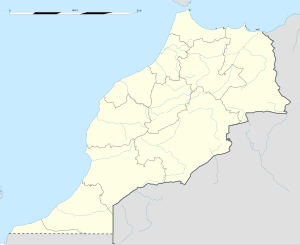Oujda-Angad Province
|
Oujda, Morocco Wejda / ⵡⴻⵊⴷⴰ / وجدة |
|
|---|---|
| location of Oujda in Morocco | |
| Coordinates: 34°41′21″N 1°54′41″W / 34.68917°N 1.91139°W | |
| Country | Morocco |
| Region | Oriental |
| First settled | Roman times |
| Modern city | 994 |
| Elevation | 470 m (1,540 ft) |
| Population | |
| • City | 551,767 |
| • Rank | 8th in Morocco |
| • Urban | 494,252 |
| Time zone | WET (UTC+0) |
| • Summer (DST) | WEST (UTC+1) |
Oujda (Berber: ⵡⴻⵊⴷⴰ,Wejda ; Arabic: وجدة) is the capital city of the Oriental region of eastern Morocco. It is located about 15 kilometres (9 miles) west of the Algerian border and about 55 km (34 miles) south of the Mediterranean Sea.
There is some evidence of a settlement during the Roman occupation, which seems to have been under the control of Berbers rather than Romans.
The city was founded in 994 by Ziri ibn Atiyya, Berber chief of the Zenata Maghrawa tribe. Ziri was, with his tribe, authorised to occupy the region of Fas, but feeling insecure in that region and that town, and wishing to be nearer to the central Maghrib homeland of his tribe, he moved to Wajda, installed there a garrison and his possessions, appointing one of his relatives as governor. In the mid-11th century, a new quarter with a wall was allegedly added to the primitive core. Yusuf ibn Tashfin occupied the city in 1079, and in the next century, it came under Almohad control, with its fortifications repaired and strengthened under the Almohad caliph Muhammad al-Nasir.
In the mid-11th century, Oujda acquired prominence through its strategic position on the road east from Sijilmasa. Throughout the history of the dynasties of the Muslim West, Oujda played an important strategic role among the Merinids, settled in Fes, in this case as a rear base in their conflict with the Abdalwadids of the Kingdom of Tlemcen.
The city was rebuilt in the 13th century by sultan Abu Yusuf Yaqub. The city experienced great difficulty in making peace with its neighbours to the east, and sometimes to the west, because of its position in respect to the clashes between the Saadi dynasty and Turks. It was torn between the rulers of Fes and the disputed Tlemcen, and from the 16th century, it was contested by the Alaouite dynasty of Morocco and the Turks in Algiers. In 1692, Sultan Ismail led in the Turks, who established their hegemony on Algeria. Oujda fell again under Turkish rule in the following century for few weeks.
...
Wikipedia

